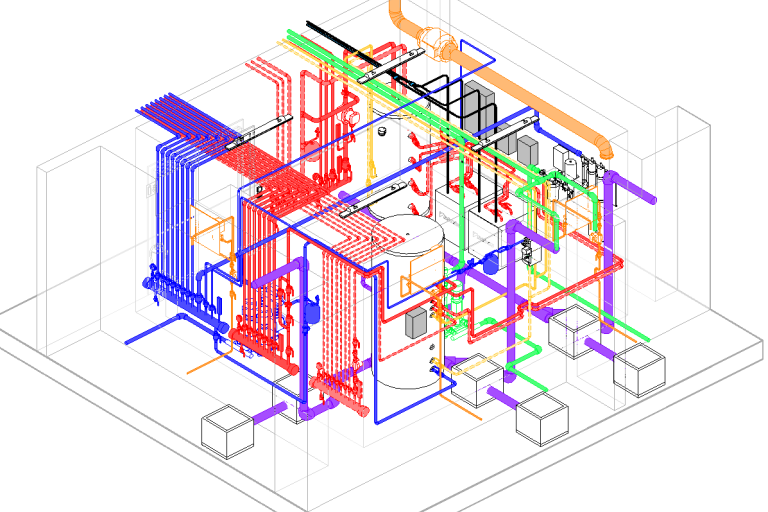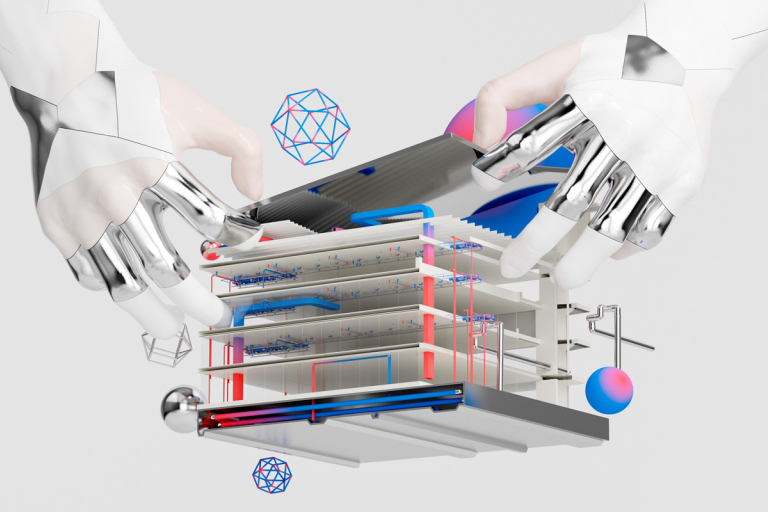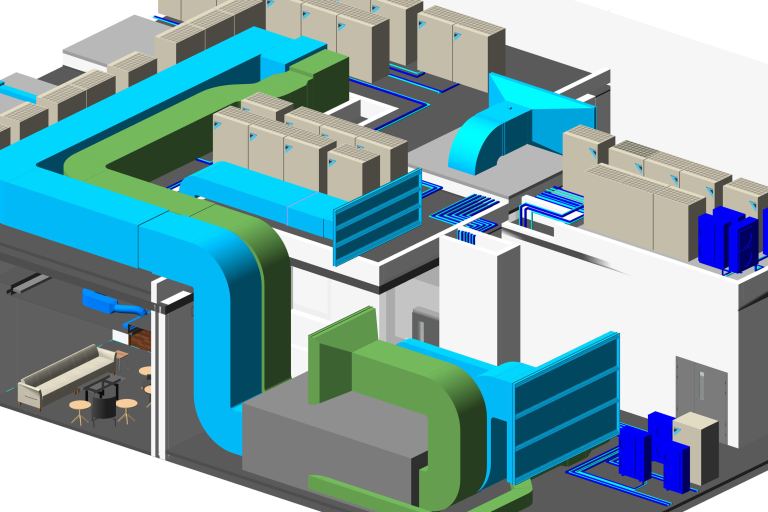Green buildings are rising stars, and their secret weapon is sustainable MEP design. Imagine buildings that breathe clean air, sip water wisely, and even generate their own power. That's the magic of MEP (mechanical, electrical, and plumbing) systems engineered for the planet. Dive into this topic and discover how smart pipes, sun-powered ventilation, and recycled materials are transforming the way we build for a greener future. ️
MEP and Sustainability
Making buildings in a way that doesn't harm the environment is getting more attention because people are realizing the problems caused by climate change. In the United States, buildings use a lot of resources. The Environmental Protection Agency says buildings use 39 percent of all energy, 12 percent of water, 68 percent of electricity, and make 38 percent of carbon dioxide emissions. To understand this better, think about an office building. The heating and cooling system (HVAC) uses 35 percent of the electricity, lights use 11 percent, and things like computers and fridges use 18 percent.
Let's break it down more. When we work in an office, the air conditioning and heating systems use a lot of energy to keep us comfortable. The lights that help us see and the machines we use, like computers and fridges, also use a good amount of electricity.
These facts show that buildings and their systems affect the environment, our health, and money. The MEP system, which includes heating, cooling, lights, and water supply, in a building is crucial for sustainability. It decides how well the building works and how much energy it uses.
For example, imagine an office where the lights adjust based on natural light, and the heating or cooling changes depending on how many people are in the room. This not only makes the place more comfortable but also uses less energy and water.
So, it's important to plan and design MEP systems well. This means using less energy, water, and electricity to make buildings more eco-friendly and reduce their carbon footprint. Doing this not only helps the environment but also saves money and makes our future better.

Crafting Green Buildings: Essential MEP Design Strategies
MEP (Mechanical, Electrical, and Plumbing) systems play a crucial role in green building design. These systems are responsible for the building's lifeblood – its energy, water, and air – and therefore hold immense potential for reducing environmental impact. Here are some key strategies for sustainable MEP design systems:
Lowering Energy Usage in Commercial Buildings
Commercial buildings are notorious energy guzzlers, with lighting and HVAC systems alone devouring a staggering 25% and 32% of their total energy consumption. So, energy-conscious architects and engineers can wield the power of MEP design to improve it.
- Adhering to national and state building codes for the building's shell, roof, floor, walls, and windows helps minimize energy demands before they even arise
- Installing motion-sensor lighting fixtures that switch lights on when people enter a space and off when they leave, eliminating unnecessary energy drain. Bonus points for using eco-friendly light fixtures and bulbs that illuminate beautifully while sipping on energy.
- HVAC systems with the help of AI technology automate processes, optimize energy usage, and even predict weather patterns to adjust the indoor temperature accordingly.
- IoT devices monitor the outside temperature and relay valuable intel to the HVAC system. This allows for real-time adjustments, ensuring your building is never overheated or undercooled.
Energy Modeling for Smarter Building Decisions
Think of energy modeling like a crystal ball for your building, revealing its predicted energy appetite before a single brick is laid. Using intricate computer calculations, it simulates how much energy your project will consume, empowering designers to make informed decisions and helping owners peek into the future of their energy bills.
At its core, energy modeling software serves as a verification document, ensuring your building meets stringent energy performance codes set by cities or coveted sustainability certifications like LEED.
Efficient Water Management
Green-house efficient water systems are the game-changers, slashing gas emissions by a whopping 80%. Think solar hot water systems soaking up the sun's rays, electric heat pumps extracting warmth from the air, or even gas-powered systems with advanced efficiency.
Solar hot water systems: Harness the sun's free energy to heat your water, lowering your carbon footprint and reducing dependence on fossil fuels.
Electric heat pump hot water systems: These clever devices extract heat from the air or ground, minimizing energy consumption and keeping your water toasty.
High-efficiency gas hot water systems: If gas is your jam, upgrade to an AAA-rated system that maximizes efficiency and minimizes greenhouse gas emissions.
Low-flow fixtures: Swap thirsty faucets and toilets for low-flow alternatives.
Rainwater harvesting design: Capture and store rainwater in cleverly designed systems for landscaping, toilet flushing, or even laundry, reducing your reliance on municipal water and helping to manage stormwater runoff.
Sustainable Materials and Practices for Optimized MEP Design
Recycled materials: From building scraps to repurposed furniture, embrace the beauty of giving materials a second life.
Right-sizing is key: Choosing equipment and materials appropriate for the scale of your project optimizes performance and minimizes waste.
Double-glazed windows: These insulating heroes act like thermal barriers, keeping the cool in and the heat out, reducing the burden on your HVAC system.
Roof vents: Let hot air naturally escape with dedicated roof vents, creating a more comfortable indoor climate.
Light-colored roofs: Reflecting heat away, these clever roofs keep your building cooler and reduce the workload on your air conditioners.
Shading solutions: Strategically placed window shades act like sunblock, shielding interiors from harsh sunlight and further reducing the AC strain.

Unimaginable Benefits of Outsourcing MEP Design
Save Time and Money by Hiring Experts
Building projects need smart people who know pipes, wires, and air vents. These folks design systems that work well and don't bump into each other. Finding and training these experts takes time and money. But when you hire someone else to do this part (outsourcing), you don't have to worry. It's like hiring a whole team of pros overnight!
Use the Best Tools without Buying Them
Just like you wouldn't buy a fancy pizza oven for one slice, you don't need to buy fancy design software for one project. Those experts you hired? They have all the best tools already! You get to use them without spending a dime.
See Your Project from Anywhere
No need to be glued to your desk! Share your project online and everyone can see it, no matter where they are. Architects, engineers, even the construction crew can all stay updated on their phones or laptops. It's like having a magic window into your project from anywhere!
Your Secrets are Safe
Worried about someone stealing your project ideas? Don't be! These experts take data security seriously. It's like locking your house, but with extra-strong digital locks. They'll keep your information safe and sound.
The Best Deal, All Wrapped Up
Get top-notch design work done at a great price, on time, and with all your information protected. It's like winning the lottery for your project! So, skip the headache of hiring and training, and let the pros handle the nitty-gritty. You'll save time, money, and get a stress-free project experience!

Come here! Come to the world MEP design of Harmony AT to experience the best service. Our MEP design services are the top of the world. Contact us here for more information!
Categories





